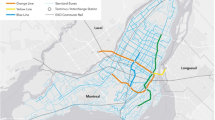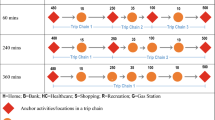Abstract
Ride-hailing (RH) services have been growing rapidly and gaining popularity worldwide. However, many transit agencies are experiencing ridership stagnation or even decline. Understanding the correlation between RH trips and transit ridership has become an urgently important matter for transit agencies. This study aimed to explore the relationship between RH and public transit ridership and provide a starting point for future studies. This study benefitted from having access to detailed data on trip-level RH trips, transit supply and transit ridership in Toronto for three years (2016–2018). With this dataset, the study utilized random-effects panel data models and log–log regression models to estimate the correlation of RH pickup/drop-off counts with subway station and surface transit route (buses and streetcars) ridership within transit catchment areas, broken down into five different periods of a non-summer weekday. The results show that RH services generally have a positive association with subway station ridership while negatively correlating with surface transit route ridership. The positive relationship between RH and subway station ridership is the strongest during the mid-day and early evening. In contrast, the negative relationship between surface transit routes and RH ridership is the highest during peak commuting hours. Additionally, RH trip volume is more positively related to ridership at terminal/transfer subway stations in Toronto’s city centre while more negatively associated with routes with relatively poor services (e.g., low on-time performance, low vehicle running speed and low frequency) in the city centre where traffic congestion can be severe. According to the above findings, the degree of the relationship between RH and public transit demand tends to be mixed, varying by transit mode, time of day and transit level-of-service. The gained knowledge about RH and transit can provide insights for transit agencies to improve transit services, which are discussed in this paper.



Similar content being viewed by others
References
Alemi, F., Circella, G., Handy, S., Mokhtarian, P.: What influences travelers to use Uber? Exploring the factors affecting the adoption of on-demand ride services in California. Travel Behaviour and Society 13, 88–104 (2018)
Anderson, M.L.: Subways, strikes and slowdowns: The impacts of public transit on traffic congestion. American Economic Review 104(9), 2763–2796 (2014)
Boisjoly, G., Grisé, E., Maguire, M., Veillette, M.P., Deboosere, R., Berrebi, E., El-Geneidy, A.: Invest in the ride: A 14 year longitudinal analysis of the determinants of public transport ridership in 25 North American cities. Transportation Research Part A: Policy and Practice 116, 434–445 (2018)
Brown, A. E. (2018). Ridehail revolution: Ridehail travel and equity in Los Angeles (Doctoral dissertation, UCLA).
Cane, T. (2018). Staff Report: Executive Summary (Report No. DSR-028–18). https://innisfil.ca/wp-content/uploads/2019/05/DSR-028-18-Innisfil-Transit_-Launch-of-Stage-2-Pdf.pdf
Castiglione, J., Cooper, D., Sana, B., Tischler, D., Chang, T., Erhardt, G. D., ... & Mucci, A. (2018). TNCs & congestion.
Chiou, Y.C., Jou, R.C., Yang, C.H.: Factors affecting public transportation usage rate: Geographically weighted regression. Transportation Research Part A: Policy and Practice 78, 161–177 (2015)
Chow, L.F., Zhao, F., Liu, X., Li, M.T., Ubaka, I.: Transit ridership model based on geographically weighted regression. Transp. Res. Rec. 1972(1), 105–114 (2006)
Circella, G., & Alemi, F. (2018). Transport policy in the era of ridehailing and other disruptive transportation technologies. In: Advances in Transport Policy and Planning. Academic Press. 1; 119–144
City of Toronto, The Transportation Impacts of Vehicle-for-Hire in the City of Toronto. https://www.toronto.ca/wp-content/uploads/2019/06/96c7-Report_v1.0_2019-06-21.pdf. Accessed 15 June 2019.
Clewlow, R. R., & Mishra, G. S. (2017). Disruptive transportation: The adoption, utilization and impacts of ride-hailing in the United States.
Diab, E., D. Kasraian, E. J. Miller and A. Shalaby (2019) The Rise and Fall of Transit Ridership Across Canada : Understanding the Determinants. Presented at the Transportation Research Board 98th Annual Meeting, Washington, D.C.
Durning, M., Townsend, C.: Direct ridership model of rail rapid transit systems in Canada. Transp. Res. Rec. 2537(1), 96–102 (2015)
Erhardt, G. D., Roy, S., Cooper, D., Sana, B., Chen, M., & Castiglione, J. (2019). Do transportation network companies decrease or increase congestion?. Science advances. 5(5), eaau2670.
Graehler, M., Mucci, A., & Erhardt, G. D. (2019). Understanding the Recent Transit Ridership Decline in Major US Cities: Service Cuts or Emerging Modes?. In Transportation Research Board 98th Annual Meeting, Washington, DC.
Greene, W. H. (2003). Econometric analysis. Pearson Education India.
Hall, J.D., Palsson, C., Price, J.: Is Uber a substitute or complement for public transit? J. Urban Econ. 108, 36–50 (2018)
Henao, A., Marshall, W.E.: The impact of ride-hailing on vehicle miles traveled. Transportation 46(6), 2173–2194 (2019)
Hoffmann, K., Ipeirotis, P., & Sundararajan, A. (2016). Ridesharing and the Use of Public Transportation.
Kuhnimhof, T., Buehler, R., Wirtz, M., Kalinowska, D.: Travel trends among young adults in Germany: increasing multimodality and declining car use for men. J. Transp. Geogr. 24, 443–450 (2012)
Lee, Y., Circella, G., Mokhtarian, P. L., & Guhathakurta, S. (2019). Are millennials more multimodal? A latent-class cluster analysis with attitudes and preferences among millennial and Generation X commuters in California. Transportation. 1–24.
Litman, T.: Evaluating rail transit benefits: A comment. Transp. Policy 14(1), 94–97 (2007)
Litman, T.: Evaluating public transit benefits and costs. Victoria Transport Policy Institute, Victoria, BC, Canada (2015)
Loa, P., Hawkins, J., & Habib, K. N. (2019). Report 4: Evaluating the Impacts of Private Transportation Companies on Travel Behaviour through a Stated Preference (SP) Survey. University of Toronto Transportation Research Institute.
Mazareanu, E.: Monthly Users of Uber’s Ride-haring App Worldwide 2016–2019. Statista. https://www.statista.com/statistics/833743/us-users-ride-sharing-services/, Accessed 20 July 2019.
Miller, J. E., Shalaby, A., Diab, E., & Kasraian, D. (2018). Canadian Transit Ridership Trends Study. Final Report Submitted to the Canadian Urban Transit Association. http://cutaactu.ca/sites/default/files/cuta_ridership_report_final_october_2018_en.pdf.
Mucci, R. A. (2017). Transportation network companies: Influencers of transit ridership trends.
Murphy, C. (2016). Shared mobility and the transformation of public transit (No. TCRP J-11/TASK 21).
Rayle, L., Dai, D., Chan, N., Cervero, R., Shaheen, S.: Just a better taxi? A survey based comparison of taxis, transit and ridesourcing services in San Francisco. Transp. Policy 45, 168–178 (2016)
Sadowsky, N., & Nelson, E. (2017). The impact of ride-hailing services on public transportation use: A discontinuity regression analysis.
San Francisco County Transportation Authority. TNCs and Congestion. 2018. 18 https://www.sfcta.org/emerging-mobility/tncs-and-congestion
Schaller, B. (2018). The new automobility: Lyft, Uber and the future of American cities.
Siddiqui, F.: Falling Transit Ridership Poses an 'Emergency' for Cities, Experts Fear. Washington Post. https://www.washingtonpost.com/local/trafficandcommuting/falling-transit-ridership-poses-an-emergency-for-cities-experts-fear/2018/03/20/ffb67c28-2865-11e8-874b-d517e912f125_story.html?noredirect=on&utm_term=.4e1c34a0fb85, Accessed 20 July 2019.
Statistics Canada. (2016). Census Profile, 2016 Census. Retrieved June 7, 2019, from https://www12.statcan.gc.ca/census-recensement/2016/dp-pd/prof/details/page.cfm?Lang=E&Geo1=CMACA&Code1=535&Geo2=PR&Code2=35&Data=Count&SearchText=Caledon%20East&SearchType=Begins&SearchPR=01&B1=All.
Taylor, B. D., & Fink, C. N. (2003). The factors influencing transit ridership: A review and analysis of the ridership literature.
Taylor, B.D., Miller, D., Iseki, H., Fink, C.: Nature and/or nurture? Analyzing the determinants of transit ridership across US urbanized areas. Transportation Research Part A: Policy and Practice 43(1), 60–77 (2009)
Tirachini, A., del Río, M.: Ride-hailing in Santiago de Chile: Users’ characterisation and effects on travel behaviour. Transp. Policy 82, 46–57 (2019)
TTC (2017). Toronto Transit Commission Service Standards and Decision Rules for Planning Transit Service. https://www.ttc.ca/PDF/Transit_Planning/TTC_Service_Standards.pdf. 2017.
TTC, 2018. TTC Operating Statistics. https://www.ttc.ca/About_the_TTC/Operating_Statistics/index.jsp
Walker, J. (2012). Human transit: How clearer thinking about public transit can enrich our communities and our lives. Island Press.
Young, M., Allen, J., Farber, S.: Measuring when Uber behaves as a substitute or supplement to transit: An examination of travel-time differences in Toronto. J. Transp. Geogr. 82, 102629 (2020)
Acknowledgments
This study was partially funded by the City of Toronto through a research contract. The study was possible because RH companies shared RH trip records and the TTC provided the transit ridership and supply information. The authors are responsible for all the results, interpretations and conclusions.
Author information
Authors and Affiliations
Contributions
The authors confirm contribution to the paper as follows: study conception and design: Amer Shalaby and Khandker Nurul Habib; data compilation: Wenting Li; analysis and interpretation of results: all authors; draft manuscript preparation: Wenting Li, Amer Shalaby and Khandker Nurul Habib. All authors reviewed the results and approved the final version of the manuscript.
Corresponding author
Additional information
Publisher's Note
Springer Nature remains neutral with regard to jurisdictional claims in published maps and institutional affiliations.
Rights and permissions
About this article
Cite this article
Li, W., Shalaby, A. & Habib, K.N. Exploring the correlation between ride-hailing and multimodal transit ridership in toronto. Transportation 49, 765–789 (2022). https://doi.org/10.1007/s11116-021-10193-5
Accepted:
Published:
Issue Date:
DOI: https://doi.org/10.1007/s11116-021-10193-5




